Products from 27 companies provide new ways to handle old problems
Micrel’s (www.micrel.com) MAQ5280 is the industry’s first 120-V LDO designed and qualified for the automotive market. The device takes only 31 µA of quiescent current, has a typical shutdown current of 0.02 µA, a PSRR of greater than 80 dB, and delivers 25 mA of output current. Super Talent’s (www.supertalent.com) MasterDrive KX Micro SATA SSD uses a space-saving Micro-SATA connection, has 150/100 Mbyte/s max. read/write speeds, and runs on 3.3 V. Exar (www.exar.com) has released the XRP7603 and XRP7604 LED drivers that can handle up to 0.5 and 1 A, respectively, with a 4.5 to 29-V operating range and an operating frequency of 1.2 MHz.
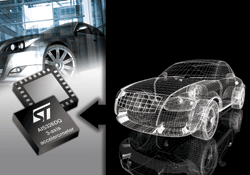
The AIS326DQ MEMS inertial sensor three-axis, low-g accelerometer from STMicroelectronics (www.st.com) has a digital output and meets automotive-industry requirements for non-safety applications such as vehicle alarms, tracking and monitoring, black-box systems, seat controls, navigation support and antenna positioning. It features a full-scale range of ±2 or ±6 g, 40 to +105C operation on a 3.3-V supply, and 12-bit resolution. In March, leading automobile manufacturers and influential technology providers announced the formation of the GENIVI Alliance (www.genivi.org), a nonprofit organization committed to driving the adoption and development of an open-source In-Vehicle Infotainment platform. Founding members include BMW Group, Delphi, General Motors, Intel, Magneti Marelli, PSA Peugeot Citroën, Visteon, and Wind River, which are all collaborating to create a common software architecture scalable across product lines and generations.
Atmel (www.atmel.com) recently introduced the ATA6617 LIN automotive-networking applications SIP combining a LIN transceiver, voltage regulator, watchdog with a AVR ATtiny167 microcontroller in a single package. Featuring SPI and Microwire bus interfaces, National Semiconductor’s (www.national.com) LM95172Q digital temperature sensor monitors automotive system temperatures up to 175°C with ±1°C accuracy between 130° and 160°C. Manufactured on an automotive-grade flow that meets AEC-Q100 Grade 0 qualification requirements, the device offers a 16-bit sigma-delta A/D, a temperature switch, and self-diagnosis. The PCI-9524 from Adlink Technology (www.adlinktech.com) is a 24-bit load-cell input card that provides four strain-gauge-based transducer input channels, four general-purpose analog input channels, and a three-axis motion controller.
The HSAutoLink interconnect system from Molex (www.molex.com) is an emerging high-speed data bus that supports in excess of 1-GHz performance at lengths of 8 m with up to five in-line separable links. Lynguent (www.lynguent.com) has joined forces with APEI, NCREPT, and Cree, to apply for a Department of Energy grant under its Electric Drive Vehicle Battery and Component Manufacturing Initiative. Lynguent will use its ModLyng Integrated Modeling Environment (IME) to deliver models of the manufactured components as an executable datasheet. These executable datasheets will be available to system integrators even before the components are available, allowing concurrent model-based engineering.
The VIA (www.via.com.tw) IVP-7500 is a versatile, scalable processor platform with strong multimedia performance that can be employed as DIN in-dashboard designs as well as in-seat and headrest designs. It can be used for in-car multimedia entertainment, GPS, fleet management, and security applications such as license plate recognition.
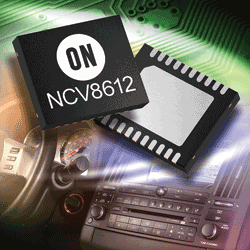
ON Semiconductor (www.onsemi.com) has introduced the NCV8612 multiple-output linear regulator IC with an automatic switchover input voltage selector that selects between three different input voltage sources to reduce power dissipation and to maintain output voltage. Fujitsu Microelectronics (www.fujitsu.com/us) has launched the MB88395 automotive controller that transmits high-definition video over the 1394 in-vehicle multimedia network. It includes a high-speed 800-Mbit/s physical layer and link layer, along with a proprietary codec. Cirrus Logic’s (www.cirrus.com) CS47048 is an audio system-on-a-chip that integrates a 32-bit audio DSP (150 MHz), high-performance multichannel audio codec, and a SPDIF receiver/transmitter, yielding an all-in-one audio solution with 108 dB dynamic range and 98-dB THD+N.
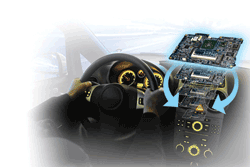
WinSystems’ (www.winsystems.com) industrial CompactFlash cards are used automobiles and trucks due to their high reliability and ability to emulate IDE hard-disk drives. They operate from 40° to 85°C and withstand up to 2,000 g of shock and 16.3 g rms of vibration. Lattice Semiconductor (www.latticesemi.com) has announced the availability of automotive-temperature-qualified (AEC-Q100) low-cost chip-scale 132 BGA packaging for the XP2-5 and XP2-8 nonvolatile FPGA devices with five thousand and eight thousand LUTs. The LAN89218 from SMSC (www.smsc.com) is a full-featured single-chip 10/100 Ethernet controller designed and tested for 16/32-bit automotive-grade applications including diagnostic and system test interfaces.
The ZMD31170-ASSP sensor signal conditioner from ZMD (www.zmd.de) features a LIN 2.1 interface, digital compensation of offset, gain, and nonlinearity, advanced automotive protection features, and up to 12-bit resolution. Samples are available now and production is planned for first quarter 2010.
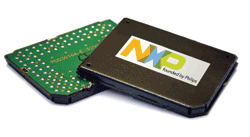
The ATOP from NXP Semiconductors (www.nxp.com) is a multicore, close to turnkey, solution for automotive telematics applications combining a GSM/GPRS, GPS, SRAM and flash, an ARM7-based MCU with CAN, USB, multiple serial interprocessor buses, a security controller based on banking standards accepted security levels, and an RFID interface.
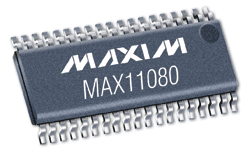
The Maxim Integrated Products (www.maxim-ic.com) MAX11080 80-V 12-channel battery-monitoring IC for large lithium-ion (Li+) battery stacks used in hybrid vehicles provides redundant cell monitoring to prevent thermal runaway and employs a proprietary capacitor-isolated daisy-chain interface. The Saber simulation solution from Synopsys (www.synopsys.com) enables virtual robust design of today’s complex mechatronic systems. With over 30,000 MAST and VHDL-AMS parts in its model library and tools for creating and converting models, Saber provides a fast start for the entire automotive supply chain.
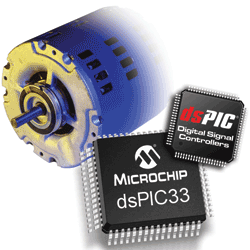
With the Microchip Technology (www.microchip.com) dsPIC33FJ32MC302 digital signal controller, engineers can reduce noise, improve torque response, provide higher efficiency, and raise reliability via sensorless motor control of BLDC motors used in stability control, braking, wipers, fuel pumps, water pumps and electronic power steering. C&K Components (www.ck-components.com) K5 series low-profile snap-acting key switches with dual functionality are being used in car window and sun-roof controls. The switches feature silver- or gold-plated dome inserts for enhanced user feel, provide excellent tactile feedback, superior acoustics, and small low-profile packages. KP cable receptacles from ITT Interconnect Solutions (www.ittcannon.com) are specified for use in automotive test equipment, as well as engine, valve, and gearbox controls. The sealed connectors are particularly useful in applications where quick connect/disconnect is required and they have a current rating of 7.5 or 10 A.
BI Technologies (www.bitechnologies.com) offers the HA55 power inductor rated at 180 degrees C for automotive underhood environments. Inductance values range from 7 to 20 µH, recommended frequency is up to 400 kHz and saturation current is as high as 50 A. The National Instruments (www.ni.com) CompactRIO rugged embedded real-time system programmed with LabVIEW graphical design software comes with a wide variety of I/O modules including CAN and custom sensor interfaces. The system is used in several automotive applications ranging from in-vehicle datalogging to engine control prototyping. The Advantech (www.advantech.com) ARK-1388 fanless, rugged, compact in-vehicle computing system connects the GPRS/3.5G network and touch-panel screens to audio and GPS navigation systems. With its efficient thermal design and excellent shock and vibration protection, the unit is used in trucks, buses, taxis, and trains.
Jim Harrison
Advertisement
Learn more about Electronic Products Magazine





